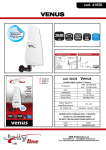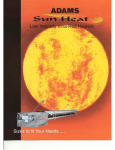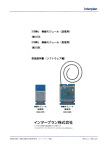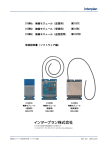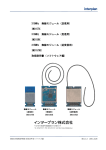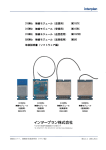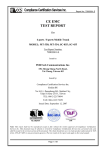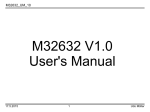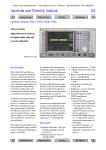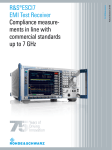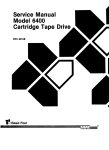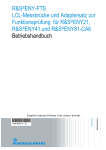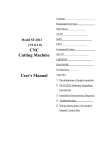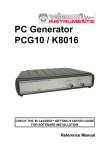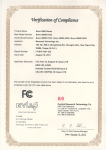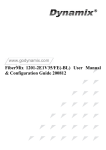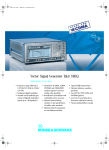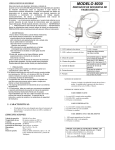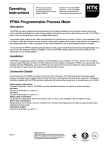Download ESHS10 EMI Receiver
Transcript
Eshs_de.fm Seite 1 Mittwoch, 8. September 1999 1:40 13 EMI Test Receivers ESHS 9 kHz to 30 MHz • Comply with CISPR 16-1, VDE 0876 and ANSI C63.2 • For measurements to European • Level measurement range −36 to +137 dBµV • Frequency resolution 10 Hz Standards 55011 to 55022, • Wide dynamic range ETS, FCC, VCCI and VDE 0871 • High measuring accuracy to 0879 • Five preselection filters • Battery or AC supply • Parallel detectors for average, peak and quasi-peak indication • Macros for automatic test runs Eshs_de.fm Seite 2 Mittwoch, 8. September 1999 1:40 13 Functions Features The EMI Test Receivers ESHS10 and 30 • Frequency range 9 kHz to 30 MHz are double-conversion heterodyne re- • RF attenuator switchable in 10-dB ceivers covering the frequency range steps in range 0 to 120 dB; high from 9 kHz to 30 MHz. They can be ma- pulse loading capacity of input permanently activated peak detectors nually operated, featuring high frequency resolution and accurate level in- attenuator (100 mWs) • Preamplifier with wide dynamic • Logarithmic amplifier with more than 70 dB dynamic range • 12-bit A/D converter with short conversion time • IF filters with low delay distortion • Flash EPROMs allowing convenient and fast firmware updating dication, both average and quasi- range, can be switched between peak. preselection filter and 1st mixer • Digital level indication on LC dis- • Crystal-controlled synthesizer as play and analog level indication Thanks to the built-in intelligence of the 1st LO, variable in 10-Hz steps, on moving-coil meter taking into test receivers, the time required for sweep mode for fast frequency account transducer factors and measurements is reduced considerab- scans their units ly. Being specialists for EMI measurements to CISPR, CENELEC, ETSI, FCC, VCCI and VDE standards, these test receivers furnish results at a speed and accuracy not possible previously. Their real strength, however, is the automatic measurement of RFI voltages. For this measurement, the test receivers control the artificial mains network, detect the line with the highest RFI level, compare the results with the permissible limits and furnish a comprehensive test report with all the necessary information. • High-level input mixer ensuring high isolation of 1st LO • Field-strength measurements using test antennas • Highly linear envelope detector with more than 70 dB dynamic range Both receiver models combine three classes of instruments in one: – a compact, manually tunable and battery-operated test receiver – an automatic test receiver which automatically performs measurements and reports the results – a system-compatible test receiver 2 EMI Test Receivers ESHS • Peak, average and quasi-peak detectors operating in parallel • Peak indication with automatic consideration of IF bandwidth correction factors for measuring broadband interference (PK/MHz) • Automatic overload detection in mixer stages and in test channel by • High measuring accuracy: error ≤1 dB; typ. ≤0.5 dB • Detection of faulty modules by built-in selftest facilities Eshs_de.fm Seite 3 Mittwoch, 8. September 1999 1:40 13 Result of complete, automatic RFI voltage measurement to CISPR 22, class B. Curves: fast prescan measurement using peak (blue) and average detector (green) simultaneously. */+: result of final measurement with long measuring time (1 s) at frequencies with highest levels of prescan measurement; *: quasi-peak value, +: average value. List of final measurement results is plotted separately. Time required for complete measurement including documentation: approx. 4 min • Manual operation or automatic test with spectrum display on screen • Built-in 3½" disk drive for storing test results and instrument settings • Built-in tracking generator for attenuation and gain measurements Manual operation For solving complex EMC problems, manual measurement often is the most efficient way, since the operator can make full use of his experience in identifying interference sources. ESHS10 and 30 feature conventional test receiver operation with tuning knob, indication of results on a meter and built-in loudspeaker. ESHS30 provides IF analysis in addition. The clear arrangement of the controls – all keys being assigned one function • Automatic calibration at a keystro- • Output of results as lists and dia- only – and the LC display of the selected ke with the aid of a high-precision grams on printer or plotter inclu- parameters such as attenuation, band- built-in 100-kHz harmonics genera- ding limit lines and user-definable width and detector ensure great ease of tor labelling operation. The display is easy to read • Demodulator circuits for AM and A0; headphones connector and built-in loudspeaker • Automatic monitoring of all synthesizer loops and supply voltages du- • Nonvolatile storage of 9 complete transducer factors and limit lines • Manual operation or automatic test The input keys for automatic measure- ring operation ments are arranged on the left of the Additional features of ESHS30 preamplifier) • Measurement of voltage, field front panel. A row of menu keys are provided below the screen to enter fre- without preamplifier, third-order intercept point typ. 20 dBm (without Automatic operation with report on printer or plotter • Wide dynamic range: noise figure typ. 5 dB with preamplifier, 10 dB in any ambient light. instrument settings and 22 different • IF analysis for visual check of inter- quency scans, limits, transducer fac- ference spectrum in manual measu- tors, configuration data and macros for rement mode; IF analysis module test routines. strength, current and pulse spectral with resolution bandwidth of 1, 3 density with full indication of units and 10 kHz; IF analysis executed In a frequency scan (lin or log), up to automatically during level measu- five subscans are covered; each subs- rement can can be assigned a specific test re- • Automatic consideration of frequency-dependent transducer factors • Indication of level on analog meter and digital display with 0.1-dB resolution • 60-dB operating range also for quasi-peak and average indication • Optimal result display for every application • Display of interference spectra ceiver setting. Nonvolatile storage of 22 limit lines and transducer factors with up to 50 values is possible. By (RF ANALYSIS) including limit lines combining the transducer factors, all on low-emission screen configurations occurring in practice • Full storage and listing of results can be covered. EMI Test Receivers ESHS 3 Eshs_de.fm Seite 4 Mittwoch, 8. September 1999 1:40 13 Remote control The IEC/IEEE-bus interface complies with the latest standard IEEE 488 Part 2. The measured values are output with a resolution of 0.01 dB. Interfaces For further signal evaluation and for driving or feeding add-on units, ESHS10 and 30 have the following interfaces: • IEC/IEEE-bus interface • Coding and supply socket (ANTENNA CODE) for active antennas and other accessories The results of a frequency scan are mation is automatically added to the usually first displayed in graphical form parameters known to the ESHS such as (80 kHz OUTPUT) for evaluating on the screen and then output on a prin- date, time and receiver settings. the IF signal eg with an oscillos- ter as a list and/or on a plotter as a • IF output 80 kHz cope graph. Time can be saved by simulta- Macros for automatic test runs neous printing of the lists and plotting of (ANALYSIS OPTIONS) match the (VIDEO OUTPUT) for evaluating the graphs. Plotting is also possible du- ESHS10 and 30 to the specific configu- the detected IF signal eg with an ring the frequency scan so that the desi- ration, device under test and measure- red document is already obtained du- ment specification. Being thus prepa- ring the measurement. Any relevant in- red, the test receivers perform the follo- formation can be added to the test re- wing sequences automatically: port, either by entering it via a line editor or, more conveniently, via an MF2 keyboard that can be connected. Infor- the peak and/or average detector quencies – for RFI voltage measurements on all phases of the artifical mains network (LISN) – using the average and/or quasi peak detector • Report of results on printer or plotter • ESHS30: storage of results on floppy disk • Determination of critical frequencies by means of limit lines with data reduction to shorten the measuring time The minimum configuration consisting of ESHS10 or 30, artificial mains network (LISN) and plotter is already a powerful and cost-effective test set. EMI Test Receivers ESHS oscilloscope • Connector for an MF2-compatible keyboard for text entry • Input for an external reference frequency (5 or 10 MHz, automatic • Fast prescan measurement using • Final measurement at critical fre- 4 • Envelope detector output detection) Eshs_de.fm Seite 5 Mittwoch, 8. September 1999 1:40 13 • USER INTERFACE with – RS-232 interface for reprogram- – 6 TTL ports for driving external devices, eg for phase selection of the Artificial Mains Networks ESH2-Z5 and ESH3-Z5 when updating the firmware via The service-friendly modular design of an AT-compatible computer the ESHS10 and 30 in conjunction with a consequent design to EMC rules inclu- • Parallel interface – input for external triggering of measurements – outputs for the analog display voltage with and without simulation of the meter response for connecting a discontinuous inter- Design ming the built-in flash EPROMs (PRINTER INTERFACE) for connec- ding the low-emission screen ensures ting a printer excellent results regarding RFI emission • IF output 74.7 MHz for connecting and immunity. a panoramic display (ESHS10 only) • Connector (11 to 33 V) for battery- A faulty module can easily be found by powered operation, eg in a vehicle the built-in selftest and replaced with a minimum of effort and without affecting ference analyzer the other modules. Specifications Frequency range Frequency setting Display Resolution Setting error RF input VSWR Oscillator reradiation at RF input (0 dB RF attenuation) without preamplifier with preamplifier Preamplifier Gain Preselector Maximum input level (with and without preamplifier) RF attenuation 0 dB DC voltage Sinewave AC voltage Pulse spectral density RF attenuation ≥10 dB (DC-coupled) DC voltage Sinewave AC voltage Max. pulse voltage (10 µs) Max. pulse energy (10 µs) 9 kHz to 30 MHz 1. with tuning knob in 10-Hz, 10-kHz steps or any step size (switch-selected) 2. numerical keyboard entry 3. in steps of any selectable size 4. automatic scanning (RF analysis) 7-digit LCD 10 Hz <3 × 10 −6 +30 Hz Zin =50 Ω, N connector, female <1.2 with ≥10 dB RF attenuation, <2 with 0 dB RF attenuation <20 dBµV <10 dBµV switchable between input filter and 1st mixer 10 dB five bandpass filters 9 kHz to <150 kHz 150 kHz to <4.05 MHz 4.05 MHz to <12.8 MHz 12.8 MHz to <21.55 MHz 21.55 MHz to 30 MHz Interference rejection, non-linearities Image-frequency rejection 1st IF >90, typ. 100 dB 2nd IF >75 dB IF rejection >90, typ. 100 dB Intercept point d3, with |f1-f2 | ≥100 kHz and 0 dB RF attenuation Preamplifier off on Level (f1, f2) at receiver input fin <2 MHz fin ≥2 MHz Intercept point k2 IF bandwidths Nominal bandwidth −3 dB (±20%) −6 dB 200 Hz 1) 150 Hz 200 Hz +20/−30 Hz 9.5 kHz ±0.5 kHz 10 kHz ) 7V(^ = 1 W) 137 dBµV 700 V 100 mWs −20 dBm typ. 0 dBm >0 dBm typ. +5 dBm >20 dBm RF shielding Voltage indication at a field strength of 10 V/m with 0 dB RF attenuation (f ≠fin) <−10 dBµV Additional error in quasi-peak indication range <1 dB Intermediate frequencies 1st IF 74.7 MHz 2nd IF 80 kHz 2 7V 130 dBµV 96 dBµV/MHz −10 dBm typ. 15 dBm >15 dBm typ. +20 dBm >40 dBm 7 kHz Shape factor BW6 dB/BW50 dB =1:8 (typ.) BW6dB/BW60 dB =1:3.5 (typ.) 1) Meets tolerances to CISPR 16. 2) Meets tolerances to CISPR 16 (min. 8 kHz, max. 10 kHz) and complies with MIL tolerance (10 kHz ±10%). EMI Test Receivers ESHS 5 Eshs_de.fm Seite 6 Mittwoch, 8. September 1999 1:40 13 Noise indication Preamplifier Average value, BW=200 Hz fin =9 to 50 kHz fin >50 kHz off on <−24 to <−30 dBµV <−30 to <−36 dBµV <−30 dBµV <−36 dBµV typ. −35 dBµV typ. −41 dBµV Average value, BW=10 kHz fin > 50 kHz <−14 dBµV <−20 dBµV typ. −17 dBµV typ. −25 dBµV Peak value, (typ. increase as against +11 dB average value) Quasi-peak Band A (9 to 50 kHz) typ. −24 to −30 dBµV typ. −30 to −36 dBµV (50 to 150 kHz) typ. −32 dBµV typ. −38 dBµV Band B (≥150 kHz) typ. −13 dBµV typ. −19 dBµV PK/MHz (BW=10 kHz) typ. 34 dBµV/MHz typ. 28 dBµV/MHz Voltage measurement range (f in >50 kHz) Lower limit (additional error caused by inherent noise <1 dB Preamplifier off on Average indication (AV) BW=200 Hz <−26 dBµV, typ.−31 dBµV <−32 dBµV, typ. −37 dBµV BW=10 kHz <−10 dBµV, typ.−13 dBµV <−16 dBµV, typ. −20 dBµV Peak indication (PK) BW=200 Hz typ. −8 dBµV typ. −14 dBµV BW=10 kHz typ. +10 dBµV typ. +4 dBµV Quasi-peak indication (QP) CISPR band A (pulse freq. 25 Hz) typ. −30 dBµV typ. −36 dBµV CISPR band B (pulse freq. 100 Hz) typ. −11 dBµV typ. −17 dBµV Upper limit AV, PK, QP 137 dBµV (RF attenuation ≥10 dB) Inherent spurious response <−10 dBµV (equiv. input voltage) Level display digital in dBµV, dBµA, dBm, dBµV/m, dBµA/m, dBpW analog Operating ranges Screen (RF analysis) (ESHS30 only) Resolution Display range X axis (frequency) Y axis (level) Display modes Averaging, hold and measuring times Measuring error AV for S/N >16 dB Level calibration Demodulation modes IF analysis (ESHS30 only) Display range Resolution Nominal bandwidth 10 kHz 3 kHz 1 kHz Sweep time Level display range Input attenuation Date, time of day 6 EMI Test Receivers ESHS 3½ digits, resolution 0.1 dB on moving-coil meter in operating range of IF detector with additional digital display of lower range limit 30, 60 dB 5" CRT with digital display memory 1024 x 1024 pixels freely selectable between 9 kHz and 30 MHz 10 to 200 dB, adjustable average (AV), peak (PK), spectral density measurement (PK/MHz), quasi-peak (QP) 1 ms to 100 s (1/2/5 steps) <1 dB (digital display), typ. <2 dB (analog display) harmonics generator Floppy disk drive (ESHS30 only) Formatting Data format Connectors and interfaces Remote control Remote-control connector Plotter to IEC 625-2 (IEEE 488.2) 24-contact Amphenol connector via IEC/IEEE-bus interface Front-panel outputs Supply and coding connector for antennas etc AF output EMF 12-contact Tuchel connector Zout =10 Ω, jack JK34 adjustable up to 2 V Generator output (ESHS30 only) EMF N connector, female, 50 Ω 96 dBµV±1 dB Rear-panel outputs IF 74.7 MHz (ESHS10 only) Gain ref. to RF input (RF attenuation 0 dB) Bandwidth (−3 dB) IF 80 kHz EMF in range of analog level display for unmod. sinewave signal: Operating range 30 dB 60 dB Bandwidth=IF bandwidth Video output (envelope detector) EMF in range of analog level display: Operating range 30 dB 60 dB User interface Printer connection Keyboard connection Rear-panel inputs Ext. reference frequency Required level Frequency Ext. battery Required voltage Rated temperature range Storage temperature range ESHS30: temperature range for floppy disk drive Mechanical stress EMC 10 kHz 1:4 3 kHz 1:6 1 kHz 1:9 50 ms to 10 s (adjustable in 1/2/5 steps) 80 dB 0/20 dB, selectable internal clock, permanently operated from internal battery Zout =50 Ω, BNC connector, female 10 dB without preamplifier, 20 dB with preamplifier >2 MHz or bandwidth of preselector Zout =50 Ω, BNC connector, female 1 to 30 mV 1mV to 1 V BNC connector, female 4 to 126 mV 4 mV to 4 V 25-contact Cannon connector; includes 6 control lines for an external device (eg artificial mains network), display voltage (analog) with and without simulation of meter response, input for external triggering, RS-232-C interface for firmware updating parallel interface, 15-contact Cannon connector DIN connector (5-contact) for MF2 keyboard BNC connector, female EMF ≥1 V from 50 Ω 5/10 MHz 3-contact connector 11 to 33 V General data A0 (zero beat) A3 (for A3E emissions) 10 kHz to 2 MHz in 1, 2, 5 steps −3 dB Shape factor (±20%) BW 3dB :BW 60dB 3½", 1.44 Mbyte formatted MS-DOS-compatible HP-GL or binary Power supply AC supply Battery Internal (ESHS10 only) External ESHS10 ESHS30 −10 to +55°C (no condensation allowed) −25 to +70°C +5 to 50°C shock-tested to MIL-STD-810D (shock spectrum 40 g), vibration-tested to MIL-T-28800D, class 5; complies with IEC Publ. 68-2-6 to EMC directive of EU (89/336/EEC) and German EMC law 100/120/240 V ±10%, 230 V +6/−10%, 47 to 420 Hz (80 VA) safety class I to VDE 0411 (IEC348) 12 V, 10 Ah, operating time approx. 4 h 11 to 33 V, 1.2 A at 24 V, 2.3 A at 12 V 2.1 A at 24 V, 3.9 A at 12 V Eshs_de.fm Seite 7 Mittwoch, 8. September 1999 1:40 13 Dimensions incl. controls (W × H × D) ESHS10 435 mm × 236 mm × 363 mm ESHS30 435 mm × 236 mm × 463 mm Weight ESHS10 ESHS30 21 kg/18 kg with/without batteries 28.6 kg Ordering information Order designation EMI Test Receiver ESHS10 EMI Test Receiver ESHS30 Accessories supplied ESHS30 in addition 1004.0401.10 1002.9001.30 power cable, connector for external battery, operating manual, N- to-BNC adapter hood for screen Recommended extras For interference measurements: RF Current Probe (9 kHz to 30 MHz) ESHS30: Current Probe 20 Hz to 100 MHz Active Probe (9 kHz to 30 MHz, high-impedance) Passive Probe (9 kHz to 30 MHz, VDE 0876) Four-line Artificial Mains Network (9 kHz to 150 kHz/30 MHz, VDE 0876) Four-line Artificial Mains Network (150 kHz to 30 MHz, 200 A) Double Two-Wire ISN to CISPR22 for unshielded telecommunication ports Four-Wire ISN to CISPR22 for unshielded telecommunication ports Antenna Impedance Converter Two-line V-Network V-Network 5 µH || 50 Ω Attenuator (20 dB, 10 W) Rod Antenna Rod Antenna (MIL) Loop Antenna (9 kHz to 30 MHz) Loop Antennna (9 kHz to 1 MHz) Inductive Probe Tripod Wooden Tripod (for HFH2-Z6) Pulse Limiter 9 kHz to 30 MHz Highpass filter 150 kHz Option 3 additional RJ45 adapter sets for ENY41 ESH2-Z1 0338.3516.52 EZ-17 0816.2063.02 ESH2-Z2 0299.7210.52 ESH2-Z3 0299.7810.52 ESH2-Z5 0338.5219.52 ENV 4200 1107.2387.02 ENY22 1109.9508.02 ENY41 EZ-12 ESH3-Z5 ESH3-Z6 ESH2-Z11 HFH2-Z1 HFH2-Z6 HFH2-Z2 HFH2-Z3 HFH2-Z4 HFU-Z HZ-1 ESH3-Z2 EZ-25 1110.0175.02 1026.4800.02 0831.5518.52 0836.5016.52 0349.7518.52 0335.3215.52 0837.1866.54 0335.4711.52 0335.6214.52 0338.3016.52 0100.1114.02 0837.2310.02 0357.8810.52 1026.7796.02 ENY4-B1 1109.9950.02 Other accessories 6-V Lead Acid Storage Battery, maintenance-free, 10 Ah (2 required) (for ESHS10) Keyboard (English) Keyboard (German) Headphones Service Manual ESHS10 Service Manual ESHS30 Service Kit 19" Rack Adapter with front handles without front handles Set of Front Handles Cables RF Connecting Cable (BNC) (ESHS30) IEC-bus Connecting Cable 1m 2m Printer Cable Control Cables for artificial mains networks from ESHS to ESH3-Z5, 2m from ESHS to ESH2-Z5, 2m from ESHS to ENV4200, 3 m Control Cables for artificial mains networks in shielded cabins (both cables required) from ESHS to ESH3-Z5, 2m 10 m from ESHS to ESH2-Z5, 2m 10 m from ESHS to ENV4200, 3m 10 m Feeder Cables for active antennas in shielded cabins (two required) 3m 10 m EZ-8 0338.4012.00 1009.5001.32 1009.5001.31 0110.2959.00 1004.0553.24 1003.0272.24 0816.1067.02 ZZA-95 ZZA-951 ZZG-95 0396.4911.00 0396.9488.00 0396.5176.00 PCK PCK EZ-11 0292.2013.10 0292.2013.20 0816.1767.02 EZ-14 EZ-13 EZ-21 1026.5341.02 1026.5293.02 1107.2087.03 EZ-14 EZ-6 EZ-14 EZ-5 EZ-21 EZ-21 1026.5341.02 0816.0683.02 1026.5341.02 0816.0625.02 1107.2087.03 1107.2087.10 HZ-3 HZ-4 0837.3469.02 0816.0519.02 PSA-Z1 PSA-Z1 Certified Quality System ISO 9001 DQS REG. NO 1954-02 EMI Test Receivers ESHS 7 Eshs_de.fm Seite 8 Mittwoch, 8. September 1999 1:40 13 Please send me an offer ❏ I would like a demo ❏ Please call me ❏ I would like to receive your free-of-charge CD-ROM catalog Others: ––––––––––––––––––––––––––––––––––––––––––––––––––– Printed in Germany ❏ 999 (U we) Fax Reply (EMI Test Receivers ESHS) ––––––––––––––––––––––––––––––––––––––––––––––––––– Name: –––––––––––––––––––––––––––––––––––––– Company/Department: –––––––––––––––––––––––––––––––––––––– Position: –––––––––––––––––––––––––––––––––––––– Address: –––––––––––––––––––––––––––––––––––––– –––––––––––––––––––––––––––––––––––––– –––––––––––––––––––––––––––––––––––––– Country: –––––––––––––––––––––––––––––––––––––– Telephone: –––––––––––––––––––––––––––––––––––––– Fax: –––––––––––––––––––––––––––––––––––––– E-mail: –––––––––––––––––––––––––––––––––––––– ROHDE&SCHWARZ GmbH & Co. KG ⋅ Mühldorfstraße 15 ⋅ D-81671 München ⋅ P.O.B. 8014 69 ⋅ D-81614 München ⋅ Telephone +49894129-0 Internet: http://www.rsd.de ⋅ CustomerSupport: Tel. +491805124242, Fax +4989 4129-3777, E-mail: [email protected] PD 756.3260.23 ⋅ Trade names are trademarks of the owners ⋅ Subject to change ⋅ Data without tolerances: typical values –––––––––––––––––––––––––––––––––––––––––––––––––––








